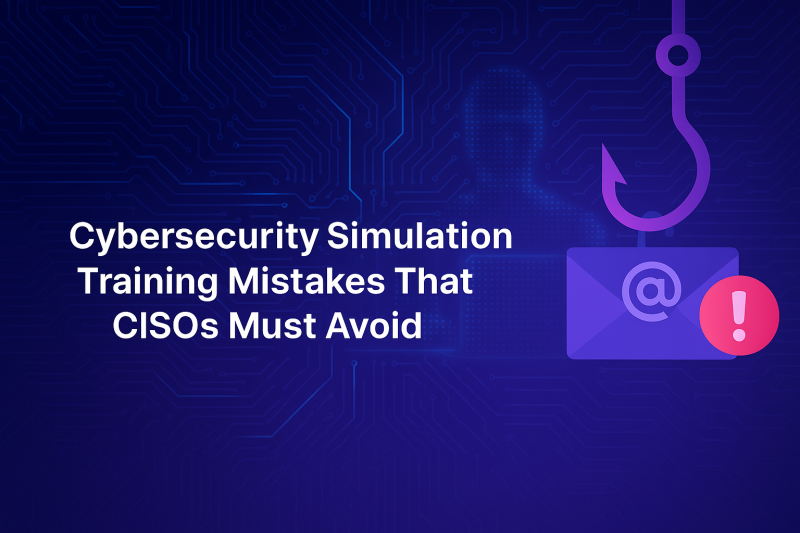Your team’s ability to identify phishing attempts in their inboxes has the potential to make or break your entire security posture, which is why having an effective training program in place is so important.
Over the years, phishing training has evolved from annual slide deck presentations in the conference room to more engaging, dynamic, interactive and personalized experiences. Today, simulation-based training has become the gold standard widely adopted among security-focused organizations.
This shift is certainly a step in the right direction, but with CISOs having to navigate a complex threat landscape and tight budgets, things can quickly go off track if the simulation program isn’t designed and executed thoughtfully.
This article highlights some of the most common mistakes CISOs make when implementing cyber security simulation training, and how to avoid them.
Ignoring Role-Specific Scenarios
With presentation-style training, it’s common to use the same materials for all employees, regardless of their roles and the types of threats they usually face. CISOs that are stuck in their old ways may try to apply that same approach to simulation training, rolling out generic scenarios that don’t really resonate with most of the recipients.
If every employee receives the same generic simulation, it will reduce the realism levels of the training, while also risking long-term disengagement. The training will be seen as a chore, not something that people view as relevant to their day-to-day work.
Every role and department in the organization faces unique threats. For example, finance typically has to deal with invoice fraud or business email compromise (BEC) attempts. On the other hand, engineers may see fake software updates or invites to malicious repositories.
CISOs must work closely with department heads to understand and define specific threat patterns each team is most likely to encounter, and tailor the training accordingly.
Failing to Tie Simulations to Real-World Threats
Aside from making the training simulations relevant for each role, they also must stay relevant to the current threat landscape. Cyberattacks, especially phishing tactics, evolve rapidly, so using outdated scenarios can create a false sense of security.
Additionally, even if the training is role-specific, employees won’t change their behavior if the examples they see are different from what they’re actually seeing in their inboxes. Sometimes, CISOs can get a little too creative with simulations, which ends up with unrealistic scenarios that may be engaging but have little real-world value.
The best source for simulation topics is in actual cyber threat intelligence (CTI) reports and vendor advisories that track real-world attack trends and social engineering tactics. Close collaboration with the rest of the security team can also bring up anecdotal evidence of suspicious emails employees are encountering.
The National Institute of Standards and Technology (NIST) also emphasizes the importance of real-world relevance. Their Phish Scale provides a framework for tailoring simulations based on actual attacker techniques and can be a valuable resource to ensure the training aligns with the sophistication of modern threats.
To keep the training fresh and relevant, CISOs should update simulation materials at least quarterly – or more frequently, if any significant threats emerge.
Turning Simulations into Gotcha Moments
The entire purpose of any kind of employee training is to educate employees so they can better serve (and protect) the organization. Unfortunately, many security teams use simulation training as a way to test or catch employees off guard, rather than to genuinely build awareness.
A good example of that is the UC Santa Cruz incident, where the university sent a phishing simulation email to employees referencing an Ebola outbreak. The emotionally charged nature of the message caused alarm and backlash, even making it into mainstream media reports.
These types of scenarios are overly deceptive and emotionally manipulative. While they may grab attention in the short term, they tend to backfire, with employees growing to resent the training, or even the IT or security team as a whole.
CISOs must see simulation training for what it is: a great way to educate employees and protect the organization, not a tool to shame or punish. The only outcome from failing a phishing simulation test is clear and supportive feedback about what the red flags were, why the message was suspicious, and what the correct response would have been.
Neglecting Data-Driven Improvements
Above else, cyber security simulation training is a strategic initiative. As such, it should be grounded in data. Without tracking performance and outcomes, there’s no way to know whether the training is actually working.
Good metrics to track include click rates and response times, on an individual, department and organization-wide level. These metrics can reveal a lot, such as which teams are improving, which individuals are more at risk, or the types of attacks employees fail at the most.
The insights you gather can then drive further actions. For example, if certain teams consistently fall for credential-harvesting emails, you can target those groups with additional support or follow-up exercises. If overall improvement stalls, it may be time to refresh the content or test new delivery methods.
With a data-centric approach, CISOs can know for sure that the program works, and that it consistently improves over time. The data can then be used in meetings with other leaders or the board to demonstrate ROI and drive more investment in cybersecurity initiatives.
Final Thoughts
Cyber security simulation training is becoming a staple in how businesses of all sizes prepare for the unrelenting pressure from phishing and other social engineering attacks.
When done correctly, simulation-based training has the power to completely transform how employees view and respond to cyber risk, addressing one of the main concerns in cybersecurity: the human factor.

